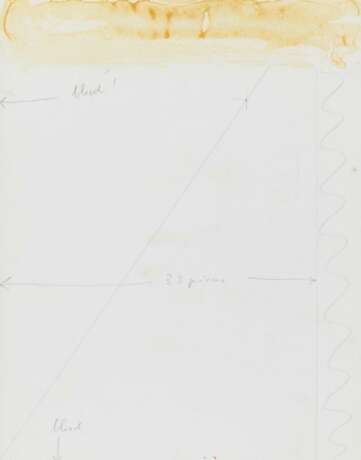ID 136617
Lot 49 | pm
Estimate value
€ 25 000 – 35 000
Knickspur an der linken oberen Ecke (ca. 9cm) sowie am rechten Rand (ca. 6cm). Ecken minimal bestoßen und mit minimalen Gebrauchsspuren. Verso Reste alter Montierung. Transparentpapier mit Gebrauchsspuren.
Wir danken The Moholy-Nagy Foundation, Inc., Ann Arbor, Michigan, für die freundliche, wissenschaftliche Unterstützung.
Provenienz:
- Sibyl Moholy-Nagy (direkt vom Künstler)
- Privatsammlung Nordrhein-Westfalen
Literatur:
- Vgl. Heyne, Renate (Hrsg.): Moholy-Nagy - the photograms. Catalogue raisonné, Ostfildern 2009, Nr. fgm 309
Als einer der einflussreichsten Lehrer am Bauhaus (zunächst in Dessau und nach seinem Berufsverbot in Deutschland auch ab Ende der 1930er Jahre am New Bauhaus in Chicago) beschäftigt sich Moholy-Nagy früh mit den technischen Verfahren und gestalterischen Möglichkeiten der Fotografie. Hierbei löst er sich vom klassischen Fotografieren mit einer Kamera und bearbeitet das Fotopapier direkt, in dem er Objekte auf das Papier legt und diese dann belichtet. Es entstehen hierdurch unvorhersehbare Muster, Schatten und Effekte, sodass Licht und die Materialität der Objekte eine einzigartige Verbindung eingehen.
Der Künstler selbst sagt zu seinen Fotogrammen: "Es existiert eine Art fotografischer Arbeiten, die ohne Kamera entstehen und die selbst dem Laien, der in der Fotografie nur ein mechanisches Notierverfahren sieht, eine wertvolle und sichere Basis für das nähere Verständnis fotografischer Wunder geben."
Moholy-Nagy beobachtet hierbei Man Ray und dessen Versuche, die klassischen fotografischen Verfahren weiterzuentwickeln und zu überwinden. "Doch auch er", so führt Moholy-Nagy an, "von Dada und amerikanischem Sentiment erfüllt, hat mit seinen Fotogrammen, wenn auch viel grundlegender, noch nicht das Elementare des fotografischen Gestaltungsmittels bewußt herausgehoben".
Moholy-Nagy hat eine andere Vorstellung seiner Fotogramme, da er sie als Weiterentwicklung seiner Malerei sieht: So sind für ihn die zentralen Aspekte des fotografischen Verfahrens die Beherrschung der Lichtintensitäten, die Schwarzweiß-Transposition sowie die helldunklen Übergänge. "Alle sekundären, imitativen Elemente, selbst Erinnerungen an sie, sollen dabei ausgeschaltet werden. Die Fotogramme müssen aus ihren eigenen, primär verwendeten Mitteln - in ihrem Aufbau nichts anderes als sich selbst zeigend und bedeutend - geschaffen werden." (zitiert aus: Ausst.-Kat. László Moholy-Nagy. Museum Fridericianum Kassel, 1991, S. 155)
Die vorliegende Arbeit entstammt der Serie der Chicago-Fotogramme, die zwischen 1937 und 1943 entstanden und kann als Variante des unter der Nummer fgm 309 im Werkverzeichnis der Fotogramme (Heyne/Neusüss, Ostfildern 2009) verzeichneten Fotogramms angesehen werden. Die Übermalung "pm" deutet darauf hin, dass das Werk ein Entwurf für die Grafikdesign-Zeitschrift PM-Magazin war. Dieses wurde 1934 gegründet und veröffentlichte bis Ende 1942, Hefte zu drucktechnischen und typografischen Themen. Das Heft entwickelte sich schnell zu einer der ersten Plattformen, auf der junge US-amerikanische oder aus Europa emigrierte Künstler ihr Können zeigen konnten. So verwundert es nicht, dass sich eine der Ausgaben im Frühjahr 1937 komplett der Bauhaus Schule widmete. Die Zeitschrift änderte 1939/1940 ihren Namen in A-D Magazine. (Vgl. http://www.drleslie.com/PMADMagazines/Magazines.shtml)
| Auction house category: | Photography |
|---|
| Auction house category: | Photography |
|---|
| Address of auction |
VAN HAM Kunstauktionen GmbH Hitzelerstr. 2 50968 Köln Germany | ||||||||||||||
|---|---|---|---|---|---|---|---|---|---|---|---|---|---|---|---|
| Preview |
| ||||||||||||||
| Phone | +49 221 92586215 | ||||||||||||||
| Fax | +49 221 92 58 62 4 | ||||||||||||||
| Buyer Premium | 32% | ||||||||||||||
| Conditions of purchase | Conditions of purchase | ||||||||||||||
| Business hours | Business hours
|






